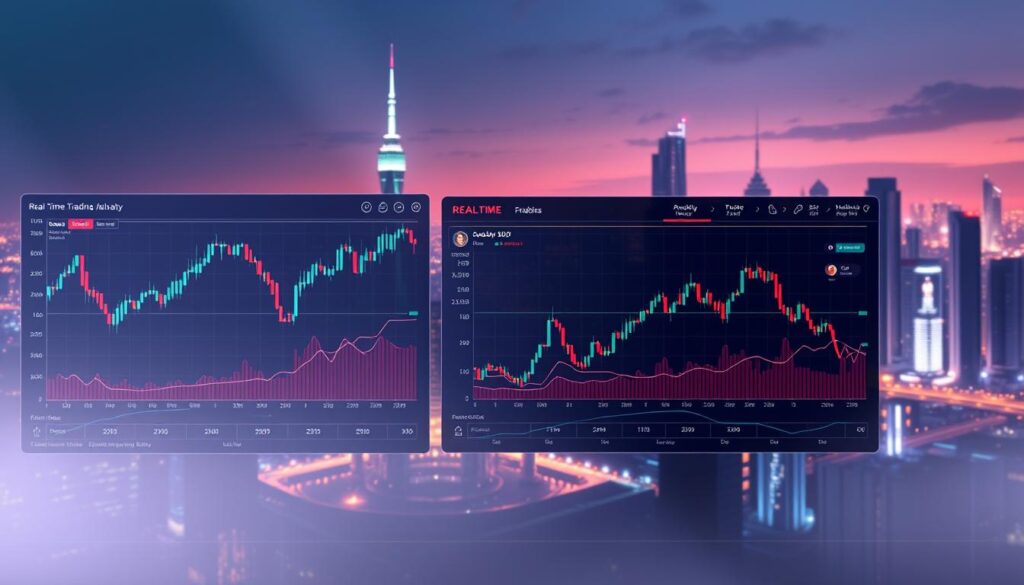Now Reading: Altcoin analysis price movement trends: Insights and Forecasts
- 01
Altcoin analysis price movement trends: Insights and Forecasts
Altcoin analysis price movement trends: Insights and Forecasts

The world of digital assets beyond Bitcoin is a dynamic and fast-paced environment. For those looking to participate, a solid grasp of how these markets work is essential. This landscape offers significant potential, but it also demands careful navigation.
This guide provides a foundation for understanding the forces that drive valuation shifts. We will explore the core principles that help make sense of market behavior. Our goal is to equip you with actionable knowledge, whether you are just starting out or have some experience.
Successful participants often combine different methods to build a clearer picture. Looking at historical data reveals patterns that can inform future decisions. By learning from the past and observing the present, you can approach this exciting space with greater strategic clarity and confidence.
Understanding the Altcoin Analysis Price Movement Trends
The cryptocurrency landscape extends far beyond Bitcoin into a diverse ecosystem of alternative digital assets. These coins operate with distinct characteristics that require specialized understanding.
Key Concepts and Definitions
Alternative cryptocurrencies represent a broad category with varying technologies and purposes. A crucial concept involves market dominance patterns, where Bitcoin’s share of total value signals shifts in investor preference.
When Bitcoin stabilizes after major gains, capital often flows toward other digital assets. This creates favorable conditions for alternative coins to experience significant growth.
Overview of Past Trends and Patterns
Historical cycles reveal consistent patterns in alternative coin behavior. The 2017-2018 period saw massive growth driven by Initial Coin Offerings that funded new blockchain projects.
More recently, the 2020-2021 cycle demonstrated how external factors like the pandemic combined with DeFi and NFT innovations. During this development phase, many tokens achieved remarkable gains while Bitcoin’s market share decreased substantially.
Understanding these historical price movements helps identify similar conditions in current markets. The altcoin season index quantifies when most major alternatives outperform Bitcoin over specific timeframes.
Fundamentals of the Altcoin Market
Understanding the structural components that define alternative crypto markets reveals important risk-reward dynamics. Market capitalization serves as a primary metric for assessing position within this ecosystem.
Market capitalization reflects total value by multiplying current price against circulating supply. This calculation helps investors gauge relative size and stability across different digital assets.
Large-cap alternative coins typically demonstrate lower volatility with established track records. These assets suit conservative strategies as portfolio core holdings. Small-cap options present higher growth potential but carry increased risk.
The altcoin market operates across numerous global exchanges. Major platforms like Binance and Kraken offer extensive selections. Decentralized exchanges provide access to newer tokens.
Liquidity considerations remain paramount when trading these assets. Sufficient trading volume ensures smooth order execution without significant price slippage. High volume reflects active investor participation.
Understanding these market fundamentals helps construct balanced portfolios aligned with individual risk tolerance. Proper assessment of value and positioning creates a solid foundation for participation in alternative cryptocurrency markets.
Technical Analysis Tools for Altcoin Trading
Chart-based evaluation methods help traders navigate the complex world of cryptocurrency markets. These approaches examine historical data to identify potential future directions. Technical analysis provides a systematic framework for market participation.
Successful application requires understanding various tools and their specific uses. Different indicators serve distinct purposes in market examination.
Moving Averages and RSI
Moving averages smooth out price fluctuations to reveal underlying direction. They help identify the prevailing trend and potential support areas. Simple and exponential variations offer different sensitivity levels.
The Relative Strength Index measures momentum on a zero to one hundred scale. Readings above seventy suggest strong upward movement. Historical data shows assets with high RSI can outperform by significant points.
Bollinger Bands and Chart Patterns
Bollinger Bands create dynamic envelopes around price action. They expand during volatile periods and contract during calm markets. Breakouts often occur when prices touch the band boundaries.
Chart patterns visualize market psychology through recognizable formations. Head-and-shoulders and triangle patterns provide clues about future price behavior. Combining multiple indicators creates stronger confirmation signals.
| Indicator | Primary Purpose | Key Levels | Typical Timeframe |
|---|---|---|---|
| Moving Average | Trend identification | Crossovers | Multiple periods |
| RSI | Momentum measurement | 30/70 levels | 14 periods |
| Bollinger Bands | Volatility assessment | Band touches | 20 periods |
| Chart Patterns | Psychology visualization | Breakout points | Variable |
Fundamental Analysis for Altcoins
Moving beyond technical indicators, fundamental research examines the core value of digital assets. This approach evaluates long-term viability rather than short-term fluctuations. It provides a deeper understanding of what drives sustainable success.
Assessing Technology, Team, and Use Cases
Thorough project evaluation begins with the whitepaper. This document reveals the technical architecture and roadmap. Strong whitepapers demonstrate clear vision and practical solutions.
The development team’s experience significantly impacts project outcomes. Projects led by seasoned professionals tend to achieve better results. Team assessment involves reviewing backgrounds and track records.
Real-world applications separate promising projects from speculative ones. Growing adoption metrics include active users and transaction volume. Community engagement often predicts long-term health.
Major announcements can serve as important catalysts. Partnerships and technological upgrades often drive significant interest. Monitoring these developments provides valuable insights for timing decisions.
Fundamental strength typically outweighs short-term volatility over time. Projects with solid technology tend to recover from market downturns. This research approach helps identify assets with genuine potential.
Market Dynamics and Liquidity Considerations
The interplay between market capitalization and trading volume reveals critical insights for investors. These metrics work together to paint a complete picture of asset behavior.
Market Capitalization and Trading Volume Insights
Liquidity represents how easily assets can be bought or sold. High trading volume typically indicates strong market participation. This creates smoother execution for trades.
Monitoring volume trends provides valuable signals about investor sentiment. Rising activity often precedes significant market movements. Volume spikes can serve as early warning signs.
Market cap combined with volume data offers deeper understanding. A large market capitalization with low volume suggests limited liquidity. This combination may present challenges for larger trades.
| Market Scenario | Trading Volume | Liquidity Level | Investor Impact |
|---|---|---|---|
| High Cap, High Volume | Consistently Strong | Excellent | Smooth execution, stable pricing |
| High Cap, Low Volume | Inconsistent | Limited | Potential slippage, wider spreads |
| Low Cap, High Volume | Spiking Activity | Volatile | Rapid price changes, opportunity/risk |
| Low Cap, Low Volume | Minimal | Poor | Difficult exits, high volatility risk |
During stress periods, liquidity becomes especially important. Assets with strong volume maintain better price stability. This protects investors from dramatic swings.
Altcoin Analysis Price Movement Trends: An In-Depth Look
Multi-timeframe assessment provides a comprehensive view of how digital assets evolve over periods. Examining daily, weekly, and monthly charts reveals patterns that might contradict or confirm each other. This layered approach helps investors make more informed decisions.
Volatility metrics offer quantitative measures of market intensity. Short-term patterns often differ substantially from medium-term behavior. Real-world data shows how volatility compounds over longer periods.

Understanding an asset’s position relative to annual highs and lows helps assess valuation opportunities. Technical reference points like support and resistance levels provide objective decision-making criteria. These data points remove emotional bias from trading strategies.
Comprehensive trend examination combines price information with volume metrics. This creates a complete picture of market conviction. Movements supported by strong volume typically indicate genuine investor interest rather than temporary fluctuations.
Decoding Investor Psychology and Behavioral Finance
Behavioral finance reveals how cognitive biases shape trading outcomes in volatile markets. Traditional models assume rational decision-making, but real-world behavior often follows emotional patterns. Understanding these psychological factors provides crucial insights for market participants.
The Role of Sentiment in Trading Decisions
Market sentiment acts as a powerful force driving digital asset valuations. Social platforms like Twitter and Reddit serve as real-time gauges of collective emotion. Shifts in discussion tone and volume often precede significant market movements.
Sophisticated sentiment analysis tools now quantify emotional market temperature. These algorithms scan social media discussions and forum activity. The resulting data helps investors identify potential turning points before they appear on charts.
Community engagement metrics provide leading indicators of sustainable interest. Active user counts and developer activity signal genuine project health. This research helps distinguish between temporary hype and lasting value.
| Psychological Bias | Market Impact | Common Manifestation |
|---|---|---|
| Fear of Missing Out (FOMO) | Rapid price inflation | Late-cycle buying surges |
| Loss Aversion | Prolonged downturns | Reluctance to sell at losses |
| Herd Mentality | Momentum amplification | Group-driven buying/selling |
The 2021 bull market demonstrated how sentiment extremes correlate with security risks. Stolen funds increased by 357.2% as market activity intensified. This pattern shows how emotional trading environments attract both legitimate investors and malicious actors.
Recognizing these psychological patterns helps develop disciplined strategies. Understanding sentiment cycles allows for better timing of entries and exits. This approach brings valuable perspective to crypto market participation.
Seasonal Variations and Altcoin Altseason Trends
Market cycles often display seasonal characteristics that create distinct opportunities for digital asset investors. These patterns repeat across different timeframes, offering valuable insights for strategic positioning.

Historical data reveals that certain months consistently show stronger performance for alternative cryptocurrencies. This seasonal effect has persisted through multiple market cycles over the past decade.
Historical Altcoin Seasons and Their Impact
Past altseasons typically lasted several weeks to a few months. During these periods, capital rotated from Bitcoin to other digital assets.
The transition often followed a predictable sequence. Large-cap alternatives like Ethereum usually led the initial surge before smaller projects followed.
Indicators for Predicting Upcoming Altseasons
The Altcoin Season Index serves as a key metric for identifying favorable conditions. This index measures relative performance against Bitcoin over specific timeframes.
A score above 75 indicates official altseason status. However, by the time the index reaches this level, optimal entry points may have passed.
Early detection requires monitoring multiple signals simultaneously. Declining Bitcoin dominance below 54% often precedes significant capital rotation. Increased trading volume and market cap percentage for alternatives provide additional confirmation.
Current altcoin season 2025 predictions suggest building momentum despite the index reading 41/100 in September. This pre-altseason phase offers potential for early positioning before major price movements begin.
Evaluating Risk and Implementing Risk Management Strategies
Strategic risk control separates successful traders from those who experience significant losses over time. Managing exposure effectively creates the foundation for sustainable participation in digital asset markets. This approach helps navigate the inherent volatility while pursuing growth opportunities.
Diversification and Stop-Loss Techniques
Spreading investments across different assets reduces exposure to individual project risks. A balanced portfolio contains positions in various market cap categories and sectors. This approach helps mitigate the impact of any single asset’s poor performance.
Stop-loss orders provide automated protection during rapid market declines. They establish predetermined exit levels that trigger automatically. This removes emotional decision-making from the trading process.
Take-profit levels ensure gains are secured rather than lost during reversals. Many professional traders risk only 1-2% of capital on individual positions. Regular portfolio reviews allow for adjustments based on changing market conditions.
Understanding the high-risk nature of these markets helps set realistic expectations. Risk-adjusted returns often matter more than absolute gains. Proper position sizing prevents any single trade from threatening overall portfolio value.
Leveraging Trading Volume and Data Analysis
Volume data provides deeper market insights than simple price charts alone. This approach examines the relationship between trading activity and price changes. It reveals whether moves have strong backing or lack real conviction.

Volume Balance and Market Sentiment
Volume balance measures investor behavior during rising and falling prices. A positive reading shows more activity on up days, indicating strong buying interest. Negative balance signals the opposite pattern.
Research across 24,580 cases shows assets with volume balance above 40 outperformed by 4.7 percentage points annually. This demonstrates the metric’s predictive power for future returns.
Technical data reveals how patterns evolve over time. Recent readings showed -95.13 for 5 days, improving to -28.34 over 66 days. This progression indicates weakening selling pressure.
| Timeframe | Volume Balance | Market Implication |
|---|---|---|
| 5 Days | -95.13 | Strong selling pressure |
| 22 Days | -56.65 | Moderate improvement |
| 66 Days | -28.34 | Weakening negative sentiment |
Traders should require volume confirmation before acting on price signals. This avoids false breakouts that lack genuine participation. Advanced analysis includes tracking unusual spikes that may indicate major positioning.
Utilizing Portfolio Management and Trading Tools
Effective portfolio management requires specialized tools that consolidate information across various platforms. These solutions help traders maintain organized oversight of their digital asset holdings. Modern systems aggregate data from multiple sources into unified dashboards.
Comprehensive platforms display real-time valuations and performance metrics. They enable informed decision-making through advanced analytical capabilities. Professional traders rely on these tools for competitive advantages.
Best Analytics Platforms and Trackers
Leading analytics platforms offer extensive charting features and technical indicators. They provide custom alert systems and historical data examination. The content provided by these platforms varies in quality and reliability.
Portfolio tracking applications automatically calculate cost basis and tax implications. They monitor performance across complex holdings spanning different platforms. These tools help optimize long-term returns through periodic rebalancing.
Exchange selection significantly impacts trading outcomes. Major platforms like Binance offer broad altcoins selections with high liquidity. KuCoin specializes in early-stage tokens, while Kraken emphasizes regulatory compliance.
| Tool Type | Primary Function | Key Features | Best For |
|---|---|---|---|
| Analytics Platforms | Market Data Analysis | Real-time charts, indicators, alerts | Technical traders |
| Portfolio Trackers | Performance Monitoring | Unified dashboard, tax calculations | Long-term investors |
| Centralized Exchanges | Trading Execution | High liquidity, security features | Active traders |
| Decentralized Exchanges | Early Access Trading | New token listings, self-custody | Risk-tolerant traders |
Security becomes paramount during volatile crypto market periods. Cold storage solutions protect against online vulnerabilities. Decentralized exchanges offer access to newest tokens but carry different risks.
Reviewing Daily to Quarterly Technical Indicators
The relationship between short-term fluctuations and long-term trajectories forms the foundation of effective technical evaluation. Different time horizons reveal distinct aspects of market behavior that traders must understand.

Multi-timeframe examination provides a comprehensive view that helps filter noise from genuine signals. This approach prevents confusion when different periods show conflicting information.
Short-Term, Medium-Term, and Long-Term Insights
Short-term technical analysis focuses on immediate momentum shifts. For Bitcoin, recent data showed it trading within a horizontal channel between 109,600 and 115,500 points.
This short-term perspective scored -38, indicating slight negative momentum. These signals require active monitoring but can generate false alerts.
Medium-term evaluation spanning several months offers more reliable trend identification. Bitcoin recently broke through a rising channel floor, suggesting slower development.
With support near 106,000 points and a falling RSI curve, the medium-term score reached 28. This timeframe balances responsiveness with reliability.
Long-term technical indicators reveal fundamental trajectory over multiple quarters. Bitcoin maintains a rising channel between 107,000 and 124,000 points.
The neutral score of 22 suggests stable long-term development. Investors should align strategies with their intended holding period for best results.
Interpreting Price Fluctuations and Volatility
Quantitative measurements reveal the dramatic difference between short-term and extended timeframe volatility patterns. The natural rhythm of markets shows intensity varying significantly across different periods. These patterns reflect collective uncertainty among participants.
Volatility measurements demonstrate how daily changes compound over time. A 1-day reading of 1.64% grows to 30.26% across 66 days. This progression illustrates the cumulative effect of market movements.
Understanding these measurements is essential for position sizing and risk management. Higher volatility demands smaller positions to maintain consistent risk levels. This approach helps navigate turbulent market conditions effectively.
| Timeframe | Volatility Measurement | Market Implication | Risk Consideration |
|---|---|---|---|
| 1-Day | 1.64% | Daily trading range | Short-term positioning |
| 5-Day | 5.54% | Weekly momentum | Medium-term adjustments |
| 22-Day | 14.69% | Monthly trend development | Portfolio rebalancing |
| 66-Day | 30.26% | Quarterly performance | Strategic allocation |
Bollinger Bands dynamically adjust to volatility conditions, widening during turbulent periods. Price touching or exceeding the bands often signals potential reversals. This tool helps identify breakout points with greater confidence.
The relationship between movement direction and volume provides crucial context. High-volume advances suggest sustainable moves, while low-volume rallies often prove temporary. This distinction helps separate genuine strength from false signals.
Alternative digital assets naturally exhibit higher volatility than established cryptocurrencies. Factors like lower market capitalization and reduced liquidity contribute to these patterns. Recognizing this helps set appropriate expectations for value changes.
Incorporating Scientific Methods and Quantitative Analysis
Scientific methodology brings rigorous validation to digital asset evaluation through systematic data examination. This approach replaces intuition with empirical evidence gathered from extensive market observation. Long-term research provides the foundation for reliable strategy development.
Academic partnerships with institutions like Oslo University strengthen analytical frameworks. These collaborations ensure methodologies withstand peer review and controlled testing. The resulting insights offer significant advantages for market participants.
Behavioral Finance and Insider Trades
Investor psychology plays a crucial role in market movements. Behavioral finance research identifies common biases like overconfidence and recency effects. These patterns appear amplified during volatile periods.
While insider trade analysis differs in decentralized markets, large wallet movements still provide valuable signals. Monitoring founder transactions and token allocations can reveal shifting sentiment. This data complements technical indicators for comprehensive assessment.
Quantitative Models and Seasonal Variations
Mathematical models detect patterns that human observation might miss. These quantitative tools analyze correlations across price data and trading volume. The statistical approach removes emotional bias from decision-making.
Seasonal variations follow predictable cycles related to tax timing and institutional calendars. Historical data shows consistent patterns during specific periods each year. Recognizing these rhythms helps optimize entry and exit timing.
Continuous validation against new market data ensures models remain relevant. This ongoing research process adapts strategies to evolving conditions. The scientific method creates a disciplined framework for sustained interest and participation.
Alternative Investment Strategies for Altcoin Traders
Sophisticated traders often explore unconventional methods to capitalize on emerging opportunities in the digital asset space. These approaches extend beyond simple buying and selling to include specialized techniques.
Presale participation offers early access to promising projects before public listings. This strategy requires careful research into project fundamentals and community backing. Monitoring launchpads and social trends helps identify promising altcoins.
Micro-cap investments present high-risk, high-reward opportunities. While most may fail, successful picks can generate exceptional returns. These strategies demand thorough due diligence and proper risk management.
Staking and yield farming provide passive income streams for traders holding digital assets. These methods leverage blockchain technology to generate returns beyond price appreciation.
Thematic investing focuses on specific sectors like DeFi or gaming within cryptocurrencies. This approach allows developing expertise in concentrated market segments.
Dollar-cost averaging reduces timing risk by systematically building positions. This disciplined approach removes emotional decision-making from the investment process.
All alternative strategies should complement core risk management principles. Proper position sizing ensures speculative investments don’t threaten overall portfolio stability.
Conclusion
Mastering the complexities of non-Bitcoin cryptocurrency investing requires continuous adaptation and learning. The altcoin market demands integrating technical evaluation, fundamental research, and sentiment assessment into a cohesive strategy.
Staying informed through reputable sources helps traders adapt to changing market conditions. Ongoing education and community engagement reveal opportunities that others might overlook. The quality of content provided varies widely, making critical evaluation essential.
Market trends in cryptocurrencies show cyclical patterns that informed investors can use strategically. However, each cycle presents unique characteristics that demand careful analysis.
Successful participation requires aligning strategies with personal time horizons and risk tolerance. The most effective traders combine systematic approaches with disciplined execution and realistic expectations.
















